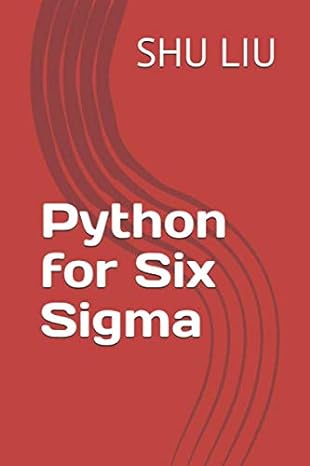Go back


Python For Six Sigma(1st Edition)
Authors:
Shu Liu

Cover Type:Hardcover
Condition:Used
In Stock
Shipment time
Expected shipping within 2 DaysPopular items with books
Access to 30 Million+ solutions
Free ✝
Ask 50 Questions from expert
AI-Powered Answers
✝ 7 days-trial
Total Price:
$0
List Price: $19.99
Savings: $19.99(100%)
Solution Manual Includes
Access to 30 Million+ solutions
Ask 50 Questions from expert
AI-Powered Answers
24/7 Tutor Help
Detailed solutions for Python For Six Sigma
Price:
$9.99
/month
Book details
ISBN: 1653888245, 978-1653888245
Book publisher: Independently published
Get your hands on the best-selling book Python For Six Sigma 1st Edition for free. Feed your curiosity and let your imagination soar with the best stories coming out to you without hefty price tags. Browse SolutionInn to discover a treasure trove of fiction and non-fiction books where every page leads the reader to an undiscovered world. Start your literary adventure right away and also enjoy free shipping of these complimentary books to your door.
Book Summary: In the era of Industry 4.0, all successful companies are transforming their production facilities into a ‘smart factory’. They are competing for real-time access to continuous flow of data from their production lines and from their customers. The rich data flow enables companies to serve customers with innovative products and services. If you, the individual employee, want to be an active contributor in this revolution, you will need to become a data scientist and a process improvement expert. As a Six Sigma practitioner, you are already equipped with skills needed to systematically solve a problem through the approach of “define, measure, analyze, improve, and control” (DMAIC). But there is more for you to learn. To become a good data scientist in the new era, you will need to develop some knowledge of machine learning techniques and learn at least one machine learning programming language. The goal of this book is to teach you how to use Python for data analytics in your Six Sigma projects. This is done by following Six Sigma’s DMAIC roadmap and by using many case studies in which mathematics are discussed prior to step-by-step instructions on Python coding. After you have read this book, you will become an expert with knowledge in using Python for your Six Sigma projects. You will have a critical new skill to prepare yourself for success in Industry 4.0.
Customers also bought these books
Frequently Bought Together
Top Reviews for Books
SHAS ak
( 4 )
"Delivery was considerably fast, and the book I received was in a good condition."










